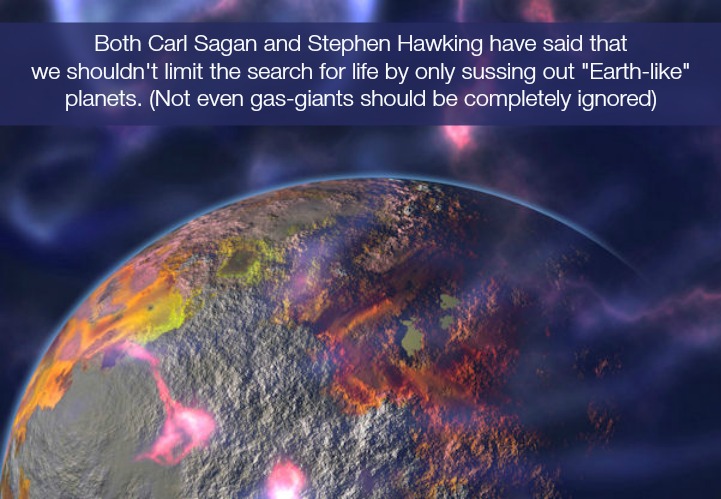

Out of the thousands of exoplanet candidates discovered by the Kepler Spacecraft., the most common planets are hot-Jupiters; exoplanets that orbit their parent star from exceptionally close distances. Any planet this large is almost certainly made up mainly of gas – with no solid surface to allow any sort of Earth-like life to begin, let alone evolve to ‘intelligence” – on. Even if they could, they would be far too hot to live on, which brings me to another point;What if life could exist on gas-giant s, but that life is so far removed from the carbon-based life-forms we are accustomed to, that we aren’t even capable of deciphering its significance? It might sound kind of ridiculous on the surface, but finding a scientist with such a position isn’t too difficult these days. After all, Stephen Hawking and even Carl Sagan have both went on the record to say that there could potentially be exotic forms of life living in the clouds of ammonia in Jupiter’s upper atmosphere.
I take this sentiment to basically say that we shouldn’t completely discount the possibility of one of these planets harboring life simply because we are unable to wrap our minds around it. Therefore, perhaps we are jilting ourselves by setting such limited parameters in search of “Earth.2.0?” With that blurb out of the way, other than the size differences,most of the exoplanets we’ve discovered have been VERY unusual. We’ve touched base on several of the more wacky planets, but to sum it up, we have found a diamond planet (55 Cancri E), one that is covered in hot ice (Gliese 436 b), another (HD 209458b) that snows titanium oxide and another, dubbed PSR B1257+12 b, that is bathed in so much radiation from its parent pulsar, it actually glows! The point is, finding uncharacteristically insane planets seems to be the rule, not the exception. Our planet is given that accolade.
In looking for so-called “Goldilocks'”exoplanets, here are a few of the desirable characteristics for one to have:
- The planet needs to lie within a certain distance from its parent star, where the planet would hypothetically be able to retain liquid water on the surface without it evaporating into space or freezing. This region has no set distance, as it depends on the size, mass and temperature of the star.
- The planet needs to remain in a stable orbit that wouldn’t take it too far beyond the habitable zone of its planetary system. Most of the planets we’ve found have highly eccentric orbits that regularly take the planet too close to its star and too far away. Any existing life on the planet would have difficulties adjusting to the harsh temperature jumps.
On that note, we shouldn’t rule any planet in one of these oblong orbits out, as we have discovered certain life-forms on Earth – like bacteri a, fungi and archaeas – that thrive in some very harsh, seemingly inhospitable environments. According to Stephen Kaine – an astronomer, who helped create the Habitable Zone gallery, which basically estimates the distance any specific planet would need to be from its parent star for any existing water on the exoplanet to remain in liquid form (no water = no carbon based life):
“Some organisms can basically drop their metabolism to zero to survive very long-lasting, cold conditions. We know that others can withstand very extreme heat conditions if they have a protective layer of rock or water. There have even been studies performed on Earth-based spores, bacteria and lichens, which show they can survive in both harsh environments on Earth and the extreme conditions of space.”
[Reference: “Extreme Life Forms Might be Able to Survive on Eccentric Exoplanets“]
He is also quick to point out that we shouldn’t necessarily limit our search to ‘super-Earth’ exoplanets. As we’ve seen with our solar system, the most habitable celestial bodies aren’t necessarily other planets, but the moons in orbit around other large, gaseous bodies. Thus, we must conclude that with our limited knowledge of alien solar system, it might not be too far from the mark to assume that moon-baring planets are the rule, not the exception, which opens up a whole new layer to the habitable planet front. I’ll leave you with one more thing to contemplate: a paraphrased quote said by Stephen Hawking: “It is more likely for there to be an unfathomable amount of foreign, alien species instead of there being none at all.” I think that definitely applies here.